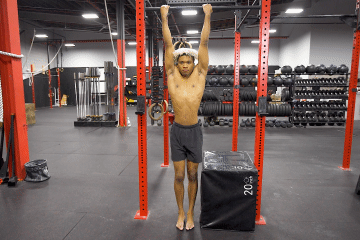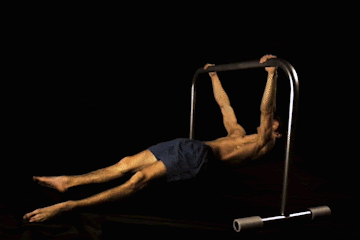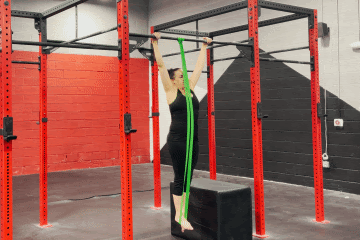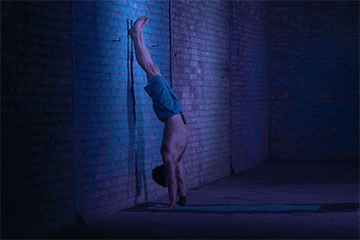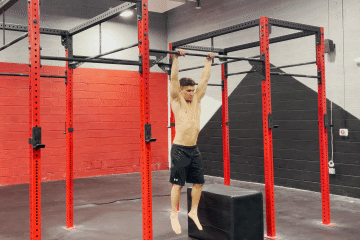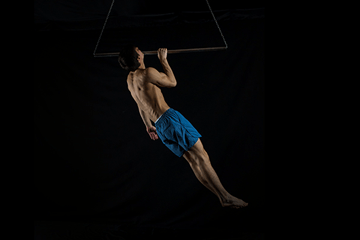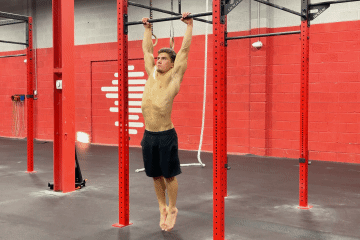Ever looked at gym equipment and thought, “There must be an easier way to work these biceps?”
You’re in luck because calisthenics is here to show you that all you need is your body weight to get those arms in shape. No fancy equipment, no gym membership—just you, your dedication, and any space you choose.
Ready to get started? This guide covers everything you need to know about bicep calisthenics, from the basics to advanced techniques. It will help you better understand your biceps, nail the perfect form, and structure your workouts for maximum gains.
But here’s the thing—what works for someone else might not be the best fit for you. That’s where personalized training comes into play. With The Movement Athlete, you get more than just workouts. You get a training plan that adapts to you—your strengths, your goals, and even how you’re feeling on any given day. It’s like having a personal trainer but tailored even more closely to your needs.
So, why not give it a try? Dive into bicep calisthenics and see how personalized training can change your workout. Sign up for an Assessment with The Movement Athlete today, and let’s make those fitness goals a reality.
Let’s roll up those sleeves and jump into The Ultimate Guide to Bicep Calisthenics. It’s time to transform your arms with strength and dedication!
✨Bicep Anatomy and Function
Before we begin with biceps exercises, let’s quickly examine their anatomy and function to boost our workouts and avoid injuries.
Getting to know the anatomy of your biceps is super important. It’s not just academic; it actually makes your workouts more effective and can help keep those pesky injuries at bay.
✊The Bicep’s Main Parts
- Long Head: Emerging from the supraglenoid tubercle of the scapula
(shoulder blade) and is crucial for the bicep’s overall profile.
- Short Head: Begins at the coracoid process of the scapula, contributing to the bicep’s thickness.
These two heads run down the upper arm, merging into a single muscle belly that attaches to the forearm bones. This unique structure allows the biceps to perform various functions essential for everyday movements and athletic activities.
✊Functions of the Biceps
- Flexion of the Elbow: The primary function allows you to bend your arm.
- Supination of the Forearm: Rotating the forearm so the palm faces up is a motion involved in many bicep-focused exercises.
- Shoulder Flexion: Assists in raising the arm in front of the body.
Understanding these functions is crucial for designing an effective calisthenics workout targeting the biceps. Exercises that involve bending the elbow, rotating the forearm, or lifting the arm will engage the biceps.
As we learn more about our biceps and how they work, we can explore bicep calisthenics, which uses exercises to sculpt and strengthen these vital muscles.
🎯Understanding Bicep Calisthenics: Mastering Strength through Bodyweight
When discussing getting those biceps to bulge, most minds jump to images of barbells and dumbbells. But what if I told you you could achieve impressive results without touching a single weight?
That’s where the magic of bodyweight exercises comes into play. By using nothing more than your own body’s resistance, you can sculpt, strengthen, and increase the size of your biceps, along with improving your overall fitness.
⚡️Fundamentals of Bicep Calisthenics
As mentioned, using one’s body weight as resistance offers many exercises targeting the biceps, from the traditional pull-up to the advanced planche push-up. These movements not only sculpt and strengthen the biceps but also promote overall upper-body muscularity and coordination. Here’s how we break it down:
- Foundation Exercises: Start with pull-ups. They’re your bread and butter for bicep and upper body strength.
Helpful article: Check out our article for achieving perfect pull-ups:📍Achieve Rapid Progress: A Step-by-Step Guide to Perfect Pull-Ups for Beginners at Home
- Advanced Moves: Progress to planche push-ups. They’ll challenge your balance and push your strength to new levels.
But here’s the deal:
- It’s About Technique: Every move in calisthenics is about precision and form. Master these, and you’ll unlock new levels of strength and endurance.
- Strength + Endurance: This isn’t just lifting weights. It’s about building a body that’s strong, resilient, and versatile.
- Customize Your Training: There is no one-size-fits-all approach. Adapt exercises to fit your goals and challenges. That’s how real progress happens.
Remember, 📍progression in calisthenics isn’t just about pushing harder; it’s about training smarter. Understand your body, refine your technique, and tailor your workouts. That’s how you achieve greatness.
⚡️Starting with Bicep Calisthenics
The Movement Athlete app emphasizes a holistic and progressive approach to fitness and focuses on developing strength, mobility, and skill through bodyweight training.
Several foundational movements in the app are particularly effective for targeting the biceps and overall upper body strength. These include pull-ups and push-up fundamentals, each contributing uniquely to building stronger biceps and a more balanced physique.
👊Pull-Up Fundamental
Pull-ups are essential for bicep strengthening within the realm of calisthenics. The Movement Athlete app has fundamentals that pull-up exercises tailored to challenge you progressively. Here’s what the pull-up fundamental looks like inside the app:
👊Push-Up Fundamental
While push-ups primarily focus on the chest, shoulders, and triceps, the Movement Athlete app introduces modifications catering to the biceps. Let’s take a peek inside the app to see how this is implemented:
🏆Crafting Your Bicep Masterpiece
When building a more muscular, stronger, and skillful physique through bicep calisthenics, it’s essential to craft your training regimen from a holistic perspective.
The Movement Athlete app adopts this comprehensive approach by categorizing training into four key pillars: Strength, Skill, Muscle, and Endurance.
Let’s explain how each category contributes to crafting your bicep calisthenics masterpiece.
-
🤸Skill Work
Technique is paramount. For bicep calisthenics, mastering the proper form in pull-ups, chin-ups, and push-up variations is crucial. Skill work focuses on the nuances of movement patterns and specific technique cues.
This foundation is critical, as it ensures safety, maximizes efficiency, and sets the stage for advanced progression. Skill work might involve drills to improve grip strength for pull-ups or techniques to engage the biceps more effectively during exercises.
-
👊Strength Work
Strength is the cornerstone of calisthenics. This category involves charting your progression through various strength movements, such as different pull-up and push-up variations, to build bicep strength.
Key strategies include optimizing reps and sets and including progressive overload principles. Strength work ensures that you’re not just performing movements but enhancing your ability to handle more challenging workouts over time.
-
💪Muscle Work
Building muscle mass is not just for aesthetics; it’s crucial for improving strength and performance. Muscle work in bicep calisthenics targets specific muscles—the biceps, in this case—to optimize volume for growth.
This might include focusing on exercises that isolate the biceps more directly or adjusting the tempo of repetitions to increase time under tension, a critical factor for muscle hypertrophy.
-
🏃Endurance Work
Endurance is often the unsung hero of calisthenics. For biceps, endurance work might involve maintaining a flexed-arm hang or repeating high-volume sets of push-ups and pull-ups within a workout.
This training aspect enhances your ability to perform at a high level over longer periods, building both mental and physical resilience.
Here’s what a training plan for push-ups looks like inside the Movement Athlete app:
💯The Movement Athlete’s Holistic Approach
The app ingeniously incorporates these elements into a structured training program designed for all-around development. By weaving warm-up and mobility, skill work, strength training, muscle building, endurance work, and cooldown with flexibility into every daily workout, the app ensures a comprehensive approach to fitness.
🔥The Free Assessment of The Movement Athlete
Before crafting your bicep calisthenics regimen, The Movement Athlete app offers a 📍free assessment. This first step is significant as it helps customize the program to align with your fitness level, objectives, and requirements.
The assessment evaluates your strengths, weaknesses, and areas for improvement, ensuring that your personalized program not only challenges you but also aligns with your specific objectives.
This holistic and personalized approach ensures that as you progress, you’re not just working on isolated aspects of fitness but are developing strength, skill, muscle, and endurance in unison.
The Movement Athlete’s commitment to well-rounded development is what sets it apart, offering a path to not just enhanced bicep strength and aesthetics but to overall physical prowess and skill mastery.
🏆Benefits of Bicep Calisthenics
As we begin our journey with bicep calisthenics, we must recognize the benefits these exercises offer, not just for our biceps but for our overall strength, flexibility, and mental fortitude.
Let’s explore the advantages and ways to integrate bicep calisthenics into your workout regimen.
- ✅ Functional Strength: Unlike isolated exercises that target biceps through curling movements with dumbbells or barbells, calisthenics involves compound movements. These workouts activate muscle groups such as the biceps, triceps, shoulders, and core, fostering functional strength applicable to everyday tasks.
- ✅ Mobility and Flexibility: Bicep calisthenics exercises often require full-body movement, enhancing range of motion and flexibility. This improvement in mobility is beneficial not only for workouts but also for daily activities, reducing the risk of injuries and improving posture.
- ✅ Mental Challenge and Satisfaction: Mastering bodyweight exercises provides a unique mental challenge. The progression from basic to more advanced movements offers continuous learning and a sense of achievement. Plus, executing flawless pull-ups or chin-ups where you control your entire body weight can be incredibly satisfying.
Understanding bicep calisthenics’ many benefits prepares us to apply progressive overload and programming to our workouts, ensuring they challenge and improve us.
🤜Progressive Overload and Programming
So what is progressive overload when it comes to biceps calisthenics?
Progressive overload is a fundamental principle in strength training and physical conditioning, including calisthenics. It involves gradually increasing the demands on the musculoskeletal system to gain muscle size, strength, and endurance.
In calisthenics, this principle can be applied by increasing the difficulty of exercises, adding more repetitions, incorporating longer holds, or reducing rest time between sets.
🤜Guidelines for Designing a Progressive Bicep Calisthenics Routine
- Start with Basic Movements
Begin with exercises that target the biceps directly or indirectly, like chin-ups and pull-ups. Ensure proper form to maximize muscle engagement.
- Increase Intensity Gradually
Once you can easily perform the basic movements, increase the difficulty. You can do this by adding more repetitions or sets or by moving to more challenging variations of the exercises.
- Incorporate Variations
Add variations to target the muscles from different angles and intensities. For example, mix close-grip and wide-grip pull-ups or use rings for added instability.
- Use Eccentric Training
Focus on the eccentric (lowering) phase of the movements. This increases time under tension, a key factor for muscle growth. Perform negative pull-ups where you jump up and slowly lower yourself down.
- Progress to Advanced Movements
As your strength improves, progress to advanced calisthenics exercises like one-arm pull-up progressions, pelican curls, and archer pull-ups.
- Rest and Recover
Allow adequate rest for muscle recovery and growth. Incorporate rest days and ensure you’re not overtraining.
- Consistency and Patience
Progress in calisthenics takes time. Be consistent with your training and patient with your progress.
💪Best Bicep Calisthenics Exercises
Knowing how to step up your game with progressive overload, let’s check out the best bicep-building calisthenics exercises.
So, what are the absolute best calisthenics exercises to work on those biceps?
Calisthenics is packed with exercises that can seriously target your biceps. It’s pretty awesome because, besides pumping up your muscles, these exercises also boost your endurance, flexibility, and coordination.
⚡️Pull-Up Variations
Pull-up variations engage your upper body and spotlight your biceps, turning every pull into pure muscle-building gold. Here are some great pull-up variations you can start with:
1. Standard Pull-Ups
Work the latissimus dorsi and significantly engage the biceps. Regular pull-ups enhance grip, which is beneficial for lifting exercises and daily activities. Altering your grip width can shift the emphasis between the lats and biceps, adding versatility.
How to do it:
- Start: Grip the bar with palms facing away (pronated grip), and hands just beyond shoulder width. Hang with arms extended.
- Pull: Engage your core, then pull up until your chin clears the bar, driving elbows down.
- Lower: Control your descent back to the starting position.
For more detailed steps on how to perfect your pull-ups, check out our article: 📍How to do a Perfect Pull-up: For Beginners to Advanced
Maximizing Bicep Engagement:
- Focus on Biceps: Think about pulling with your biceps to up their involvement.
- Narrower Grip: A tighter grip can further engage the biceps.
- Slow on the Way Down: Emphasize the eccentric phase (lowering) for growth and strength.
Standard pull-ups are a direct path to better bicep development and overall upper-body strength. Proper technique and gradual progression are key to effectiveness.
2. Chin-Ups
The supinated (underhand) chin-up grip naturally engages the biceps more directly than the overhand grip used in pull-ups.
As you pull yourself up, the biceps brachii are in a powerful position to contract, making them the primary movers in the upward phase of the exercise. This direct engagement makes chin-ups particularly beneficial for those looking to increase bicep strength and size.
Steps to Perform Chin-ups
- Start: Begin by hanging from a chin-up bar with your palms facing you, hands about shoulder-width apart.
- Pull-Up: Engage your core and pull your body towards the bar by bending your elbows and squeezing your shoulder blades together. Continue pulling until your chin is above the bar.
- Lower Down: Lower yourself back down with control until your arms are fully extended. This is one repetition.
Maximizing Bicep Engagement:
- Mind-Muscle Connection: Concentrate on pulling with your biceps and actively squeezing them during the lift.
- Controlled Tempo: Maintain a slow pace to lengthen bicep tension time, especially on the descent.
- Full Range of Motion: Move from fully extended arms to your chin over the bar for each rep.
- Volume and Frequency: Regularly include chin-ups in your routine, gradually upping reps and sets.
- Add Weight: Once proficient with body weight, use a weighted belt or vest for added challenge and muscle growth.
Looking to master chin-ups? Our article, How to Do Chin-ups: Chin-up Mastery Unveiling Muscles Worked and Performance Benefits, can help.
3. Commando Pull-Ups
Commando pull-ups, or “close-grip side-to-side pull-ups,” intensify the traditional pull-up by focusing more on the biceps, back, and forearms. With hands close and aligned, alternating the head to each side of the bar during reps, this variation not only strengthens upper body muscles but also enhances core engagement through the required rotational movements.
Steps to Perform
- Grip: Stand under a pull-up bar and grasp it with both hands close together, palms facing each other, so that your hands align with your shoulders. Your body should hang straight down from the bar.
- Pull-Up: Pull yourself up towards the bar, aiming to bring your head to one side of the bar, ensuring that your body is slightly rotated and you engage your core.
- Alternate: Lower yourself back down with control. On the next rep, pull yourself up to the alternate side of the bar. This counts as one complete rep.
- Repeat: Continue to alternate sides with each rep.
Maximizing Bicep Engagement
- Grip: Use a close grip to increase bicep workload. Ensure firm hand placement.
- Elbows: Keep elbows tight to your body to enhance bicep activation.
- Pace: Maintain a slow, controlled pace, focusing on the lowering phase to extend bicep tension.
- Range: Fully extend arms and reach high on each side for maximum bicep fiber engagement.
- Overload: Introduce added weight or resistance as you progress to stimulate bicep growth further.
⚡️Bodyweight Rows
1. Inverted Rows
Inverted rows are accessible to a wide range of fitness levels. This exercise targets the back and biceps, allowing for a solid bicep workout with reduced intensity compared to pull-ups.
It also promotes improved posture and shoulder health by strengthening the muscles around the scapulae, which is crucial for daily activities and other exercises.
Steps to do it:
- Set a bar at waist height.
- Lie underneath it, grabbing the bar with an overhand grip, arms fully extended.
- Pull your chest towards the bar, then lower back down.
Maximize Bicep Engagement:
- Grip Variation: Experiment with underhand and mixed grips to shift focus directly onto the biceps.
- Pause at the Top: Implement a brief pause when your chest is close to the bar to increase peak contraction in the biceps.
- Elevate Feet: Placing your feet on a raised platform increases the difficulty, requiring more effort from the biceps to perform the pull.
2. Archer Rows
Archer Rows places a significant emphasis on unilateral (one-sided) strength, allowing you to identify and correct imbalances between the left and right sides of your body. This focused pulling action not only targets the biceps more intensively but also engages stabilizing muscles in the shoulders and core, enhancing overall upper body strength and coordination.
Steps to do it:
- Start in a standard row position, but with one hand gripping the bar tightly and the other lightly touching.
- Pull yourself up, focusing the effort on the arm with a tight grip.
- Alternate sides after each set.
Maximize Bicep Engagement:
- Slow Eccentrics: On the working arm, emphasize a slow lowering phase to enhance the eccentric load on the biceps, boosting muscle growth.
- Increase Range of Motion: Stretch your arm fully at the bottom and pull as high as possible, engaging more of the bicep.
- Isometric Holds: At the top of the pull, hold for a couple of seconds with the working arm to maximize tension in the bicep.
3. Typewriter Rows
Typewriter rows are a dynamic and challenging variation of the traditional row that targets the upper body, specifically focusing on enhancing bicep strength and endurance. This exercise mimics the action of a typewriter carriage, where, after pulling yourself up to the bar, you move laterally from one side to the other before lowering yourself back down.
Steps to do it:
- Pull yourself up to the bar in a standard row position.
- At the top, move laterally from one side to the other.
- Lower back down after moving side to side.
Maximize Bicep Engagement:
- Controlled Sideways Movement: Ensure the side-to-side motion is performed with bicep strength, not momentum, to keep constant tension.
- Varied Tempo: Alter the tempo of your side-to-side movement, including pauses at each extreme, to challenge the biceps differently across the set.
- Increased Volume: Adding more reps or sets specifically to this exercise can help increase endurance and size in the biceps due to the sustained tension.
⚡️Isometric Holds
1. Chin-Up Isometric Hold
Chin-up isometric hold focuses on maintaining the chin-up position for extended periods, significantly increasing the time under tension for the biceps, which is key for improving muscle strength and endurance.
This static exercise enhances grip strength and recruits stabilizing muscles in the shoulders and core. It offers a comprehensive upper-body workout with a pronounced emphasis on the biceps.
Steps to Perform
- Start Position: Jump or step up to grab the chin-up bar with a supinated grip (palms facing you), hands shoulder-width apart.
- Hold Position: Pull yourself up until your chin is over the bar and hold this position. Ensure your core is engaged and your body is as still as possible.
- Duration: Hold for as long as you can maintain proper form, then lower yourself slowly back to the starting position.
Maximizing Bicep Engagement
- Grip Focus: Concentrate on squeezing the bar with your hands to intensify the engagement in your biceps.
- Elbow Position: Ensure your elbows are pointed directly beneath the bar, optimizing bicep contraction.
- Progressive Overload: Gradually increase the hold time in subsequent workouts to challenge your biceps and enhance endurance continuously.
2. Flexed Arm Hang
It is typically performed at the top of a pull-up motion and emphasizes biceps endurance by maintaining an isometric hold. This exercise targets the biceps, forearms, and grip strength similarly to the chin-up isometric hold, but it differs in that it focuses on the peak contraction point of the pull-up.
It’s an effective way to build muscle endurance and improve upper body strength, particularly in the biceps.
Steps to Perform
- Start Position: Use a box or jump to reach the top position of a pull-up, with your chin above the bar and palms facing away (overhand grip).
- Hold Position: Keep your chin over the bar, engaging your biceps and back to maintain the position.
- Duration: Hold as long as possible with good form, then lower yourself in a controlled manner.
Maximizing Bicep Engagement
- Body Alignment: Keep your body straight from head to toe, engaging your core to prevent swinging.
- Scapular Retraction: Draw your shoulder blades back and down to stabilize your shoulders and increase the work on your biceps.
- Incremental Progression: Start with shorter durations and gradually increase as your endurance improves, adding small weights if necessary to further challenge your muscles.
⚡️Towel/Band Work
1. Towel Pull-Ups
Towel Pull-Ups introduce an unconventional grip element to the traditional pull-up, significantly enhancing grip strength and providing a unique challenge to the biceps. By gripping a towel wrapped over the bar, the muscles in the forearms and biceps are engaged differently than in standard pull-ups, leading to improved muscular strength and endurance.
Steps to Perform
- Setup: Drape a sturdy towel over a pull-up bar and hold one end in each hand.
- Pull-Up: Engage your core and pull yourself upwards until your chin is level with or above the bar, focusing on squeezing your biceps.
- Lower Down: Slowly lower yourself back to the starting position in a controlled manner.
Maximizing Bicep Engagement
- Grip Variation: Experiment with different towel thicknesses or grips (e.g., closer or further apart) to challenge your biceps and forearms.
- Pause at the Top: Include a brief pause when your chin is above the bar to increase time under tension for the biceps.
- Slow Eccentrics: Emphasize the lowering phase by taking 3-4 seconds to descend, enhancing the bicep’s workload.
2. Resistance Band Curls
Resistance band curls are a versatile and effective way to target the biceps directly. They offer the advantages of portability and variable resistance. This exercise is particularly beneficial for those looking to add volume to their bicep training without relying on heavy weights, allowing for a focus on form and tension throughout the curling motion.
Steps to Perform
- Setup: Stand on the middle of a resistance band with feet shoulder-width apart, holding each end with your hands.
- Curl: With palms facing up, curl the hands towards your shoulders by bending at the elbows and squeezing your biceps.
- Lower Down: Slowly lower your hands back to the starting position, maintaining tension in the biceps.
Maximizing Bicep Engagement
- Stance Variation: Adjust your foot spacing (narrower or wider) on the band to change the tension and thus the difficulty.
- Concentration Curls: Perform curls with one arm at a time, focusing on the contraction at the top to maximize bicep engagement.
- Controlled Tempo: To increase the biceps’ time under tension, utilize a slow and controlled motion, especially in the eccentric (lowering) phase.
⚡️Handstand Variations
1. Handstand Push-Ups
Handstand Push-Ups are an advanced bodyweight exercise primarily targeting the shoulders and triceps. Performing the exercise in a handstand position requires significant strength and stabilization from the upper arms, biceps, and core, making it an effective exercise for enhancing upper body power and control.
Steps to Perform
- Setup: Begin in a handstand position against a wall for support, with your arms extended and hands placed shoulder-width apart.
- Lower Down: Slowly bend your elbows to lower your head towards the floor, keeping your body straight and core tight.
- Push-Up: Press firmly through your hands to extend your arms and return to the starting position.
Maximizing Bicep Engagement
- Body Tension: Maintain a tight body line from head to toe, engaging your biceps and core to stabilize your handstand.
- Elbow Position: Keep your elbows pointing forward during the descent to engage the biceps alongside the shoulders and triceps.
- Progressive Training: Start with partial ranges of motion or use wall support to gradually build up strength, focusing on maintaining form to engage the biceps effectively.
2. Handstand Wall Walks
Handstand wall walks are dynamic exercises that combine strength and stability, demanding considerable arm, shoulder, and core engagement. While not directly targeting the biceps, this exercise improves overall upper body strength, including the biceps, by requiring controlled movements and stabilization as you walk your hands closer to and away from a wall in a handstand position.
Steps to Perform
- Start Position: Begin in a high plank position with your feet against a wall.
- Walk Up: Slowly walk your feet up the wall while simultaneously walking your hands toward the wall, maintaining a strong, straight body position.
- Walk Down: Carefully walk your hands away from the wall as you lower your feet, returning to the starting plank position.
Maximizing Bicep Engagement
- Controlled Movements: Use slow, deliberate hand movements to increase the time under tension for your arms, including the biceps.
- Focus on Form: Keep your core engaged and back straight to stabilize your movements, which indirectly work your biceps through stabilization.
- Incremental Progression: Gradually increase the distance you walk your hands closer to the wall, enhancing the challenge and the stabilizing role of the biceps as you maintain the handstand position.
To achieve a freestanding handstand, check 📍The Ultimate Guide to Achieving a Freestanding Handstand
⚡️Advanced Techniques and Variations
Now, let’s level up with advanced techniques and variations for even greater gains. In advanced calisthenics, the pursuit of skill, strength, and muscular development takes center stage.
Individuals are challenged with exercises that demand precision, control, and a sophisticated understanding of body mechanics.
This domain is characterized by techniques such as muscle-up transitions, one-arm pull-up progressions, explosive pull-ups, and isolation movements like archer pull-ups. Each technique demonstrates the individual’s dedication, combining raw strength with the finesse of controlled movement to push physical limits and achieve mastery in calisthenics.
1. Muscle-Up Transitions
Muscle-ups combine a pull-up and a dip, moving fluidly from below to above the bar. The transition phase is critical as it requires significant upper body strength, technique, and timing.
Technique Focus: During the muscle-up transition, emphasize the “false grip” on the bar or rings. This grip helps shift wrist turnover from the pull-up to the dip phase.
Progression Tips: Start with band-assisted muscle-ups or use a low bar to practice transitioning with your feet on the ground to reduce weight. Negative muscle-ups, where you start above the bar and slowly lower through the transition phase, are also beneficial for building the specific strength required.
2. One-Arm Pull-Up Progressions
The one-arm pull-up is the pinnacle of pull strength, heavily engaging the biceps, back, and grip.
Progression Steps: Begin with uneven pull-ups, using a towel or a secondary bar to shift more weight onto one arm gradually. Progress to assisted one-arm pull-ups using bands or a counterweight. Concentrate on slow, controlled movements and gradually decrease assistance as your strength improves.
Key Pointers: Keep your core tight and focus on initiating the pull from your back and biceps. Training grip strength is also crucial for this advanced move.
3. Explosive Pull-Up Variations
Explosive pull-ups increase power and fast-twitch muscle fiber engagement, contributing to muscle growth and strength.
Progressions steps: Include clap pull-ups, where you pull up forcefully and clap your hands before grabbing the bar again, and muscle-up pull-ups, where you pull up with enough force to bring your chest above the bar.
Training Tips: Start by mastering the basic pull-up with a full range of motion and gradually increasing the explosiveness of your ascent. Plyometric exercises for the upper body can also enhance your explosive power.
4. Muscle Isolation Techniques
Isolation techniques like archer pull-ups focus on unilateral training, enhancing muscle balance, and targeting the biceps more directly.
Archer Pull-Ups: In an archer pull-up, you alternate, extending one arm sideways while pulling up with the other, mimicking the drawing of a bow. This significantly isolates the biceps and lats on the pulling side.
Implementation: Begin with easier variations, such as on a TRX or rings where your feet remain on the ground to help support some of your weight. As you progress, perform the exercise on a pull-up bar, focusing on slow, controlled movements to maximize tension on the biceps.
Incorporating these advanced techniques and variations into your calisthenics routine can significantly enhance your bicep development and upper body strength. They require not only physical strength but also a high degree of skill and coordination.
🌟Sample Workout Programs
After understanding advanced techniques and variations, let’s create sample workout programs to put it all into action.
1. Beginner
Warm-Up (5-10 minutes)
- Jumping Jacks: 2 minutes
- Arm Circles: 1 minute forward, 1 minute backward
- Dynamic Stretches (arm swings, shoulder rolls): 2-3 minutes
Main Workout:
- Chin-ups: 3 sets of 5-8 reps
- Australian Pull-ups: 3 sets of 8-10 reps
- Plank: 3 sets of 30-60 seconds
Cool Down (5-10 minutes)
- Stretching, focusing on arms, shoulders, and core: Hold each stretch for 30 seconds to 1 minute.
- Deep Breathing/Relaxation: 2-3 minutes to bring the heart rate down and relax the muscles.
2. Intermediate
Warm-Up (5-10 minutes)
- Light Jog or High Knees: 2 minutes
- Arm and Wrist Rotations: 1 minute each
- Dynamic Stretching (inchworms, leg swings): 2-3 minutes
Main Workout:
- Pull-ups: 3 sets of 8-12 reps
- Chin-ups with a slow eccentric phase: 3 sets of 5-8 reps
- Negative Pull-ups: 2 sets of 4-6 reps
- Commando Pull-ups: 3 sets of 4-6 reps per side
Cool Down (5-10 minutes)
- Static Stretching: Focus on the biceps, triceps, back, and shoulders: Hold each stretch for 30 seconds to 1 minute.
- Gentle Twists and Side Bends: 2-3 minutes to loosen the torso and back.
- Mindful Breathing: 2-3 minutes to center the mind and reduce the heart rate.
3. Advanced
Warm-Up (10-15 minutes)
- Rowing Machine or Rope Skipping: 3 minutes for an active full-body warm-up.
- Wrist and Elbow Rotations: 2 minutes to prepare the joints.
- Dynamic Stretches: Spider-Man lunges, arm swings, hip circles. These exercises take 5-10 minutes and focus on flexibility and mobility.
Main Workout
- One-arm Pull-up Progressions (assisted or negative): 3 sets of 3-5 reps per arm
- Archer Pull-ups: 3 sets of 5-8 reps per side
- Pelican Curls: 3 sets of 4-6 reps
- Ring Bicep Curls: 3 sets of 8-12 reps.
Cool Down (10-15 minutes)
- Comprehensive Stretching: Focus on deep stretches for the arms, shoulders, chest, back, and core. Hold each stretch for 45-60 seconds.
- Foam Rolling: To aid recovery and flexibility, spend 5 minutes on myofascial release, especially on the back, arms, and shoulders.
- Deep Breathing Exercises: Finish with 3-5 minutes of deep, controlled breathing to relax the body and mind, encouraging recovery and stress relief.
In each program, progress by adding more reps and sets or moving to more difficult variations as you become stronger.
Remember, the key to success with progressive overload, especially in calisthenics, is consistency, gradual progression, and proper form to prevent injuries and ensure optimal muscle development.
🤕Injury Prevention and Management
After diving into exercises and routines, let’s shift gears to preventing and managing injuries regarding calisthenics that target our biceps.
Here are the common bicep-related injuries in calisthenics and how to avoid them:
- Tendonitis: Inflammation of the tendons connecting the biceps muscle to the shoulder or elbow, causing pain, swelling, and weakness.
- Bicep Strain: It is an overstretching or tearing of the biceps muscle fibers. It often occurs during exercises like pull-ups or chin-ups due to improper form or excessive weight.
- Bicep Tendon Rupture: A complete or partial tendon rupture that links the biceps muscle to the shoulder. This injury typically occurs during high-impact activities or when the shoulder experiences sudden, excessive stress.
To avoid these injuries:
- Listen to Your Body: If something feels off, stop and assess. Pushing through pain can worsen injuries.
- Warm Up Properly: Always prepare your muscles with a dynamic warm-up before intense exercises.
- Maintain Proper Form: Use the correct technique during exercises to minimize the risk of injury.
- Rest and Recovery: Allow your muscles sufficient time to rest and rebuild to prevent overtraining and subsequent injuries.
🤔But What if I Can’t Do Some of These Exercises?
Encountering exercises you can’t perform is a common concern, especially when following a program that is not specifically tailored to your current level of fitness, abilities, and limitations. It’s crucial to approach this situation with a mindset focused on adaptation and progression rather than limitation.
The Pitfalls of One-Size-Fits-All Training
Adopting a one-size-fits-all approach to training can lead to several issues, affecting not only the progress and motivation of individuals but also their physical well-being. Here’s a list of the drawbacks of such training methodologies:
1. 💪Inadequate Personalization
Problem: Traditional training programs often divide individuals into categories based on perceived skill levels: beginner, intermediate, and advanced. This classification is overly simplistic and fails to account for the vast differences in individual capabilities, limitations, recovery rates, and personal goals.
Impact: Similar to wearing shoes that only “kind of” fit, a training program that isn’t tailored to an individual’s specific needs and objectives can be uncomfortable, less effective, and potentially harmful. The lack of customization can lead to a mismatch between the exercises selected and the athlete’s actual capacity or objectives, undermining the efficiency and enjoyment of the training experience.
2. 👊Risk of Injury
Problem: A generic regimen might not consider an individual’s unique biomechanics, existing injuries, or risk factors. As a result, participants may end up performing exercises that are inappropriate or unsafe for them, using improper form and technique.
Impact: This misalignment increases the risk of compensation injuries, where other muscles or joints take over the function to compensate for weaknesses or limitations, leading to overuse injuries or strain. Such injuries not only stall progress by forcing athletes to take breaks for recovery but can also lead to long-term health issues that might limit their ability to engage in fitness activities they enjoy.
3. 😲Frustration and Overwhelm
Problem: Progress in a one-size-fits-all program can be uneven, with individuals finding some exercises too easy and others insurmountably difficult. This is because generic programs are designed with a hypothetical average person in mind rather than tailored to meet individual needs.
Impact: Encountering exercises that seem excessively challenging or not seeing expected progress can lead to frustration and stagnation. This emotional turmoil is one of the primary reasons people feel overwhelmed and might abandon their fitness journeys. The journey, which is supposed to be empowering and rewarding, becomes a source of stress and disappointment.
🙌Take the Free Assessment with The Movement Athlete
Looking to move beyond generic workouts and unlock your fitness potential? The Movement Athlete offers a FREE assessment to tailor a training plan to your unique goals and fitness level, ensuring you see real results for your biceps and more.
Personalization is the key to effective, enjoyable, and safe training. Start your journey to powerful biceps and a stronger body today with The Movement Athlete.
🍌Nutrition for Bicep Growth
Now that we’ve covered the fundamentals and selected the best calisthenics exercises for your biceps let’s discuss the role of proper nutrition in muscle development.
Nutrition is crucial in muscle building, particularly for targeting specific areas like the biceps. The caliber and quantity of nutrients consumed have a significant impact on the process of hypertrophy, where muscle fibers increase in size.
To effectively increase muscle mass, your body requires a surplus of calories and a balanced intake of proteins, carbohydrates, and fats. This nutritional support helps in repairing muscle tissue damaged during workouts, fostering growth, and providing the necessary energy for strenuous exercise routines.
💥Macronutrient Ratios for Muscle Recovery and Growth
- Protein: Proteins are the building blocks of muscle. For muscle recovery and growth, especially in the biceps, it’s recommended to consume about 1.6 to 2.0 grams of protein per kilogram of body weight per day.
High-quality protein sources like chicken, fish, dairy, and plant-based proteins such as lentils and tofu are essential to facilitate the repair and growth of muscle fibers.
- Carbohydrates: Carbohydrates are the primary energy source for your workouts. They help replenish the muscle glycogen used during intense training sessions.
A moderate to high carbohydrate intake is crucial, depending on the intensity and duration of your workout. Aim for about 3 to 7 grams per kilogram of body weight. Good sources include whole grains, fruits, vegetables, and legumes.
- Fats: While often less emphasized, fats are vital for hormonal balance and cellular health and support muscle growth. Healthy fats should constitute about 20% to 35% of your calorie intake.
Focus on sources rich in omega-3 and omega-6 fatty acids, such as avocados, nuts, seeds, and fatty fish.
☝️Importance of Hydration for Optimal Performance
Hydration is another critical aspect often overlooked in muscle development. Water is essential for many bodily functions, including the transportation of nutrients to cells and the removal of waste products from them.
Proper hydration ensures that your muscles work efficiently and recover effectively. It can also prevent muscle cramps and fatigue during workouts, allowing for more intense and productive training sessions for bicep growth.
Adequate fluid intake varies depending on factors like sweat rate, climate, and exercise intensity. The U.S. National Academies of Sciences, Engineering, and Medicine determined that an adequate daily fluid intake is:
- About 15.5 cups (3.7 liters) of fluids a day for men
- About 11.5 cups (2.7 liters) of fluids a day for women
.
🤔Frequently Asked Questions
🔎 Can calisthenics match weights in building biceps?
Yes, with proper progression and technique, calisthenics can effectively stimulate bicep growth and strength, similar to weightlifting.
🔎 What is the optimal training frequency for bicep growth with calisthenics?
Training biceps 2-3 times weekly with various exercises and increasing intensity ensures growth and recovery.
🔎 How to avoid injuries while practicing bicep calisthenics?
Prevent injuries by warming up properly, maintaining correct form, listening to your body for cues, and ensuring adequate rest and recovery between sessions.
🔎 Can beginners see results from bicep calisthenics?
Absolutely. Beginners can achieve noticeable improvements in bicep size and strength by starting with foundational exercises and gradually progressing to more challenging variations. Consistency and proper technique are key.
Takeaway
The guide distills the essence of bicep calisthenics, presenting it as a highly accessible and efficient approach for sculpting and strengthening the biceps and the entire upper body.
It underscores the importance of personalized training regimes, recognizing the diversity in individual fitness profiles and goals. By leveraging foundational and advanced bodyweight exercises, the guide promotes the development of functional strength, enhanced mobility, and mental resilience.
The Movement Athlete app is recognized for its custom-tailored, progressive training solutions rooted in a deep understanding of bicep anatomy and function. This holistic approach not only maximizes workout efficacy but also significantly reduces injury risk, offering a comprehensive framework for achieving superior physical conditioning and muscular aesthetics through calisthenics.






